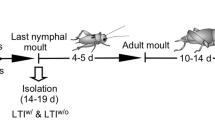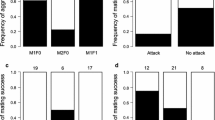Summary
-
1.
Hermit crabs (Pagurus samuelis) were held in groups and also in isolation in aquaria simulating their natural surroundings. Group-held crabs were matched against one another in a small arena to provide base-line data. Then group-held hermit crabs were matched against crabs held in isolation for 3, 8, 12, or 30 days. Individual components of behavior were quantified in terms of total seconds involved in that behavior, mean duration of each component, its frequency of occurrence, and the proportion of tests having at least one occurrence. Also noted were the latency of initiation of aggression, who initiated, who dominated, and the decisiveness of outcome.
-
2.
Aggressive actions of low rank (Series 1) were relatively unaffected by isolation. High ranking actions (Series 2), mostly those of actual combat, increased with isolation; and the higher the rank the longer was the delay to the onset of the increase.
-
3.
Dominance, decisiveness, and initiation were all hightened by isolation, but latency was unchanged.
-
4.
Locomotory behavior decreased during isolation.
-
5.
Fear behavior decreased at first, but then rose above the base-line level with further isolation.
Similar content being viewed by others
References
Andrew, R. J.: Influence of hunger on aggressive behavior in certain buntings of the genus Emberiza. Physiol. Zool. 30, 177–185 (1957).
Charpentier, J.: Analysis and measurement of aggressive behaviour in mice. In: Garattini, S., and E. B. Sigg (eds.), Aggressive behaviour, p. 86–100. New York: Wiley 1969.
Eibl-Eibesfeldt, I.: Ontogenetic and maturational studies on aggressive behavior. In: Clemente, C. D., and D. B. Lindsley (eds.), Aggression and defense: Neural mechanisms and social patterns; Univ. Calif. Los Angeles Proc. Conf. Brain Function 5, 57–94 (1967).
Hazlett, B. A.: Social behavior of the Paguridae and Diogenidae of Curaçao. Stud. Faune Curaçao other Caribb. Is. 23, 1–143 (1966a).
—: Factors affecting the aggressive behavior of the hermit crab Calcinus tibrien. Z. Tierpsychol. 23, 655–671 (1966b).
—: The behavior of some deep-water hermit crabs (Decapoda: Paguridea) from the straights of Florida. Bull. Mar. Sci. 16, 76–92 (1966c).
—: Size relationship and aggressive behavior in the hermit crab Clibanarius vittatus. Z. Tierpsychol. 25, 608–614 (1968a).
—: Communicatory effect of body position in Pagurus bernhardus (L.) (Decapoda, Anomura). Crustaceana 14, 210–214 (1968b).
Heiligenberg, W.: Ein Versuch zur ganzheitsbezogenen Analyse des Instinktverhaltens eines Fisches (Pelmatochromis subocellatus kribensis Boul., Cichlidae). Z. Tierpsychol. 21, 1–52 (1964).
Hinde, R. A.: Animal behaviour, a synthesis of ethology and comparative psychology, 876 pp. New York: McGraw-Hill 1970.
Krŝiak, M., Janků, I.: The development of aggressive behaviour in mice by isolation. In: Garattini, S., and E. B. Sigg (eds.), Aggressive behaviour, p. 101–105. New York: Wiley 1969.
Lagerspetz, K. M. J.: Aggression and aggressiveness in laboratory mice. In: Garattini, S., and E. B. Sigg (eds.), Aggressive behaviour, p. 77–85. New York: Wiley 1969.
Lorenz, K.: On aggression, 306 pp. London: Methuen 1966.
Rothballer, A. B.: Aggression, defense, and neurohumors. In: Clemente, C. D., and D. B. Lindsley (eds.), Aggression and defense: Neural mechanisms and social patterns; Univ. Calif. Los Angeles Proc. Conf. Brain Functions 5, 135–170 (1967).
Simpson, M. J. A.: The display of the Siamese fighting fish, Betta splendens. Anim. Behav. Monogr. 1, 1–73 (1968).
Valzelli, L.: Aggressive behaviour induced by isolation. In: Garattini, S., and E. B. Sigg (eds.). Aggressive behaviour p. 70–76. New York: Wiley 1969.
Ward, R. W.: Ethology of the paradise fish, Macropodus opercularis. I. Differences between domestic and wild fish. Copeia 1967, 809–813.
Welch, B. L., Welch, A. S.: Aggression and the biogenetic amine neurohumors. In: Garattini, S., and E. B. Sigg (eds.). Aggressive behaviour, p. 188–202. New York: Wiley 1969.
Yen, C. Y., Stanger, R. L., Millman, N.: Ataractic suppression of isolation-induced aggressive behavior. Arch. int. Pharmacodyn. 123, 179–185 (1969).
Author information
Authors and Affiliations
Additional information
We are grateful to Roy Caldwell, Gail Courchesne, and Rachel Courchesne for their comments on the manuscript. The writing and part of the research were supported by grants to G. W. B. from the National Science Foundation (GB 6604, GB 13426).
Rights and permissions
About this article
Cite this article
Courchesne, E., Barlow, G.W. Effect of isolation on components of aggressive and other behavior in the hermit crab, Pagurus samuelis . Z. vergl. Physiologie 75, 32–48 (1971). https://doi.org/10.1007/BF00335136
Received:
Issue Date:
DOI: https://doi.org/10.1007/BF00335136




